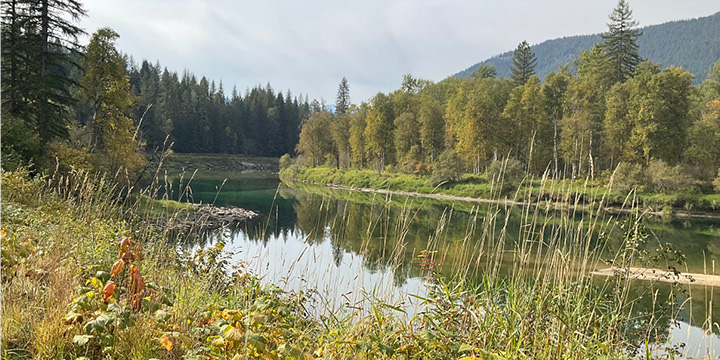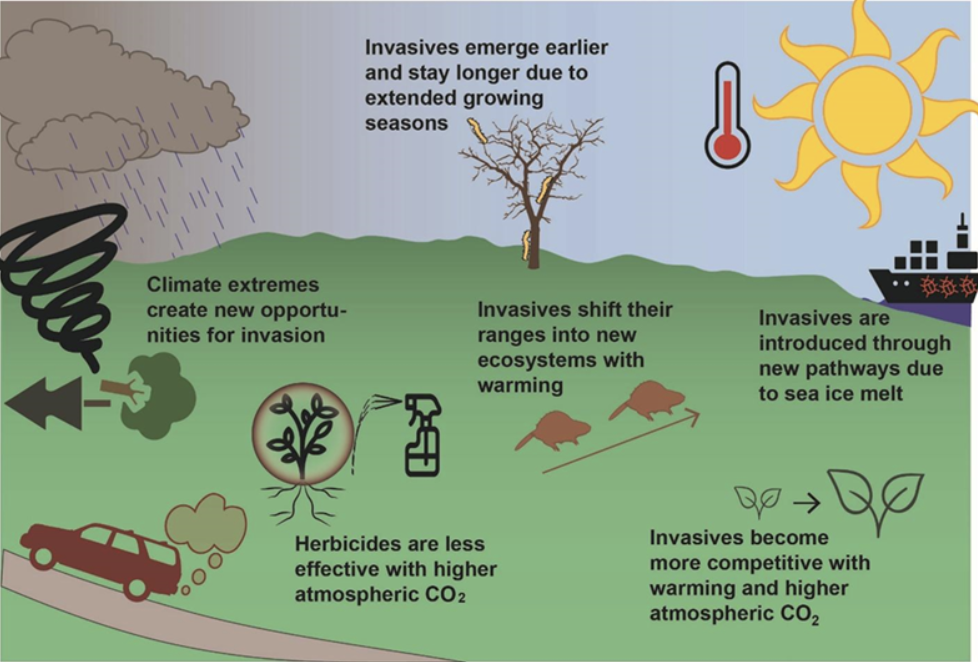
Adapted from NAISMA Climate Change and Invasive Species
Climate change can accelerate and exacerbate many of the most severe impacts of invasive species. Invasive species make both the built landscape, and the natural systems we all depend on, less resilient to the effects of climate change.
Invasive species can negatively impact climate change mitigation efforts in many North American ecosystems. Invasive tree pests reduce carbon sequestration rates in forests. Aquatic invasives decrease the resilience of green infrastructure to resist flooding and sea-level rise. Aquatic invasive species can also increase the temperatures which negatively influence the hydrologic cycle.
Invaded rangeland and forested habitats can release more carbon into the atmosphere through more severe uncontrolled fire. Invasive vegetation can reduce water flows in streams already struggling with lower water levels due to persistent drought.

Climate change legislation, policy, planning, and management that includes invasive species will result in improved preparedness for a serious threat that we can take action to address.
What Can You Do?
- Plant climate resilient and native species. See the EcoGarden project for a list of species suited to the West Kootenays.
- Report invasive species sightings to ckiss.ca
What Can Organizations Do?
- Include invasive species considerations in climate change adaptation plans.
- Plan and provide resources for invasive species detection and management in climate change response plans
- Identify and prioritize vulnerable areas for invasion.
The Problem: Climate Change and Invasive Species
There are a number of indicators that have been used to measure the changing climate, such as rising CO2 levels, altered growing seasons, increase in average temperatures, increases and decreases in rainfall, decreases in snowpack, reduction of arctic ice, increased drought conditions, rising sea level, and an increase in extreme weather events (e.g., wildfires, droughts, floods, hurricanes).
Overall, North America is experiencing more extreme weather due to climate change and with the shifting systems listed above, these changes provide ever-increasing opportunities for invasion and spread, making ecosystems more hospitable to both new and established invasive species.
Increased growth and density of invasive species due to higher CO2 levels
Under higher CO2 levels, plants often grow faster and larger. Research has shown that under the same conditions, invasive plants are able to more effectively utilize the increased CO2 when compared to native plants, and are therefore able to outcompete native species.
Warmer temperatures and drought result in more stressed trees and more abundant pests. As cities and natural habitats become hotter and drier, insects that take advantage of stressed trees may become more abundant.
New pathways for invasives to hitchhike into the Arctic
The melting of the Arctic sea ice opens new direct routes for both aquatic and terrestrial invasive species to become introduced- from both commercial shipping and new tourism pressures.
Competitive advantages for invasive species
Warm weather arriving sooner each spring is a direct effect of climate change. Research is showing that invasive species take advantage of the earlier spring warmup by sprouting and leafing out long before the native species do. This gives them an edge in which they can monopolize the soil space, nutrients, and sunlight to outcompete native species and create monocultures.
This is occurring in both terrestrial and aquatic environments. Eurasian watermilfoil (Myriophyllum spicatum) , Curly pondweed (Potamogeton crispus L.), and Leafy spurge (Euphorbia esula L.) are examples of plants that can sprout before native species. They can take advantage of warmer water or soil temperatures, and longer growing seasons, which allows them to further displace native species.
Northward shifts for invasive species due to warmer temperatures and milder winters
As the climate is warming and historic temperature-based limits on species habitats are opening up, species are shifting their ranges. Species are moving further north into spaces where they were not able to survive before. Terrestrial plants and forest pest species are both making the move north. Pests are no longer limited by historically stable and cold winter temperatures and can survive in previously uninhabitable locations.
Asian clams and water hyacinth are aquatic invasive species that are considered intolerant to cold temperatures, however their current range extends much farther north than was previously thought possible.
Carbon storage and sequestration opportunities are being lost to invasive species
Not only is climate change exacerbating the spread and impact of invasive species, invasive species are directly contributing to climate change. We are losing millions of trees to invasive pests, which directly reduces the ability of our forests to store carbon. In landscapes consistently damaged or stressed by invasives, even if the trees can survive, ecosystem health is reduced and carbon sequestration decreases.
Increased new establishment due to disturbance from extreme events
Extreme events cause native species mortality and allow invasive species opportunities to take over. Studies have shown that the woodland ground layer following disturbance from Hurricane Katrina was overwhelmingly noxious weeds. The damaged tree canopy opened opportunities for invasive species to establish. The native species are unable to compete after being damaged and stressed by the hurricane.
For example, a 2013 study in the United States showed that invasive cheatgrass alters regional fire regimes, leading to more frequent and more extensive fires.6 If future climate conditions involve both warmer temperatures and higher water availability, a novel cycle of grass fires could lead to the loss of woody shrubland species.
Waking up “sleeper” invasive species
Some non-native species are present but are not considered invasive because they do not cause significant harm. Often, this is because their population growth is limited by some naturally occuring balance within their introduced range. These “sleeping” species may take advantage of an opportunity due to the warming climate to “wake up” and become invasive. Often climate-based conditions were the limiting factor and if the climate shifts to become more suitable, the species will proliferate. For example, the mountain pine beetle (MPB) (Dendroctonus ponderosae) is native to Western Canada, but has rapidly spread beyond its historical range in recent years. Warming winters have enabled spread into areas where the cold previously killed up to 98% of populations. MPB is now acting ‘invasive’ and threatens pine trees across Canada.
Facilitating the spread of both wildlife and human diseases
Non-native viruses, bacteria, fungi, and other pathogens that harm wildlife and people may also be considered invasive species. One example is the loss of bats from the invasive fungus causing white nose syndrome, which is a deadly infection exacerbated by sudden changes in cave temperatures, and is made more severe through the effects of climate change.
Native species becoming a nuisance “neonatives”
Neonative nuisance species are native species that have established themselves beyond their historical range and begun to damage or disturb their newly entered ecosystem. Black locust is a native tree in parts of central and eastern United States, but it has been expanding this range northward. In some of its newly established ranges, such as Wisconsin and Massachusetts, it now fits the profile of a neonative nuisance species and has been declared an invasive species. Black locust has been planted in BC as an ornamental plant and is still sold in nurseries despite being listed provincially as an invasive plant. Within the CKISS region, black locust is concentrated in Kaslo, Nelson, Castlegar and Trail. This tree illustrates how a species native to one part of the continent may become a serious problem elsewhere.
Hardier invasives under higher CO2 show resistance to herbicide treatments
Climate change can also result in the reduced efficacy of control methods for the management of invasive species. Herbicides and pesticides are less effective for some species because of genetic resistance, but also because some invasive plants will absorb less of an applied treatment if they are drought-stressed.
Potential reduced effectiveness of biocontrols if phenology is mismatched
Biocontrol agents are very specifically matched to their invasive species targets. Researchers suspect that biological control agents for invasive species may become less effective due to climate change, as there are several mechanisms by which this could occur. Climate change induced changes in ranges, growth, seasonality, and reproductive rates of either the biocontrol agent or target may cause ecological misalignments and decoupling the biological control organism from its target.
Climate change creates new risks for invasive species. Similarly, invasive species can impair our ability to combat the effects of the warming climate. However, the intersection of these two fields of study that directly impact land and water management across the landscape provide opportunities to work together, share knowledge, and prevent future invasions along with the effects of climate change. Together, we can reduce the combined impacts of invasive species and climate change.
Resources
- Columbia Basin Climate Source
- CKISS EcoGarden Project- make a difference in your own backyard
- An Overview of Climate Change in Southeast British Columbia: Climate History, Climate Projections and the Scope of the Problem. Presented by Dr. Mel Reasoner.
- Preliminary Strategic Climate Risk Assessment for BC
- NAISMA Climate Change and Invasive Species Video. Presented by Carrie Brown-Lima, NY Invasive Species Research Institute.
- Regional Invasive Species & Climate Change Management Challenges
- Northwest Regional Invasive Species and Climate Change Network
